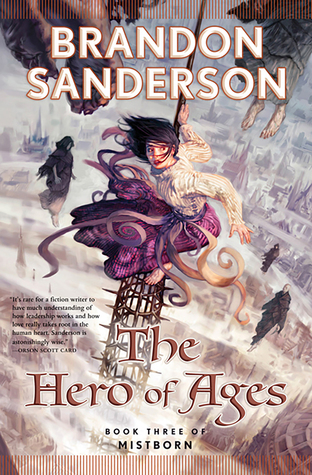I received this book for free from in exchange for an honest review. This does not affect my opinion of the book or the content of my review.

The Nine Tailors
by
Dorothy Sayers
It is part of the Lord Peter Wimsey #9 series and is a vintage mystery in a Kindle edition that was published by Open Road Media on July 31, 2012 and has 422 pages.
Explore it on Goodreads or Amazon
Other books in this series include [books_series]
Other books by this author which I have reviewed include Thrones Dominations, Whose Body?, Clouds of Witness, Unnatural Death, Lord Peter Views the Body, The Unpleasantness at the Bellona Club, Strong Poison, The Five Red Herrings, Book Review: Dorothy Sayers’ Hangman's Holiday, Murder Must Advertise, Gaudy Night, Busman's Honeymoon
Ninth in the Lord Peter Wimsey vintage mystery series and revolving around the second son of a duke with a fascination for detecting in the England of the early 1930s. It was originally published in 1934.
My Take
It’s a tale of murder, an epidemic of influenza, and a theft conspiracy of decades in a small village with bells holding it all together. Lord Peter’s accident is also a bit of luck for Fenchurch St Paul, even Lord Peter may see it that way.
Sayers provides a background and history on change-ringing — a method of using mathematical permutations and combinations to ring a group of bells which have different voices along with a history of the bellmaking (and re-making). It’s a fascinating hobby to me, as my sister-in-law was involved in change-ringing.
Who knew there were competitions of ringing bells? Yeah, it’s an individual sort of contest, but still a “game” of oneupmanship.
Ninety percent of the action takes place in the fens of East Anglia around the concerns of a small village and the events of the past which still influence today.
The betrayal with the theft and its effects on the family are so depressing, yet Sayers keeps it fascinating as she explores what happened to its participants. The deaths, the murders, the mutilations, all related through third person global subjective point-of-view, primarily from Lord Peter’s and Venables’ perspectives.
It’s sweet that Hilary is fascinated by Lord Peter’s cases and that her father would have loved talking to him. Edward, on the other hand, strongly disapproves of Lord Peter and at the idea of Hilary going on to Oxford. That Edward does sound a right prat — he’s always perfect, never makes a mistake.
I do like the Reverend Venables, as he has the parish very much at heart. Very much unlike Deacon. Now there’s a convoluted story of betrayal, escape, and death. Oy.
The mystery of the soldier who lost his memory was interesting, and so very convoluted. The mystery of the latest murdered man is even more convoluted and has some sad fall-out for a pair of brothers.
It’s amazing how well prepared the country side is when flooding threatens. Those bells do come in handy.
It’s an action-packed plot which revolves around its varied characters, leaving you both sad and a satisfaction at several mysteries solved.
Be warned, it is a slow pace with lots of talk of change-ringing, which can be a bit boring. Yet the villagers’ interactions in daily life and in the emergency satisfied me.
The Story
Lord Peter Wimsey and his manservant Bunter are halfway across the wild flatlands of East Anglia when they make a wrong turn, straight into a ditch. They scramble over the rough country to the nearest church, where they find hospitality, dinner, and an invitation to go bell-ringing. This ancient art is steeped in mathematical complexities, and tonight the rector and his friends plan to embark on a nine-hour marathon session to welcome the New Year. Lord Peter joins them, taking a step into a society whose cheerful exterior hides a dark, deadly past.
During their stay in this unfamiliar countryside, Lord Peter and Bunter encounter murder, a mutilated corpse, and a decades-old jewel theft for which locals continue to die. In this land where bells toll for the dead, the ancient chimes never seem to stop.
The Characters
Lord Peter Wimsey is wealthy with a nose for detecting and a love of old books. He also speaks perfect French and is quite friendly with the Sûreté. Mervyn Bunter is his faithful personal man; he’ll be misnamed Burner later in the story.
Fenchurch St Paul is . . .
. . . located in East Anglia and is a small village that used to be important and still has a unique church where the Reverend Theodore Venables is an elderly parson and Agnes is his patient, long-suffering wife. Mrs Tebbut is the reverend’s housekeeper; Tom is her ill husband. Emily Holliday is the maid, who makes a horrible mistake; she’s also a niece of Russell’s. Mrs Smith is Agnes’ cousin.
Lady Thorpe dies of influenza, providing an opportunity for another death, and Sir Henry Thorpe, an invalid due to a battle in Word War I at the Salient, follows soon after. Miss Hilary is their fifteen-year-old daughter. Their house is referred to as the Red House where tghe snooty Mrs Gates is the housekeeper. Johnson is the family chauffeur. Edward Thorpe is Hilary’s conservative uncle who will become her guardian and won’t allow her to go to Oxford. It was when old Sir Charles, Sir Henry’s father, was alive that the mean Mrs Wilbraham, a sort of cousin, nearly impoverished the family. Elsie Bryant had been her maid. Sir Martin Thorpe had been Hilary’s great-great-grandfather who left money for the bell-fund.
Jeff Deacon had been the butler back then at the Red House and had married Mary Russell, the housemaid. Today she’s married to William Thoday, who is ill with influenza. They have two children: Rosie and Evie. James Thoday is a sailor, a mate on a merchantman, and William’s brother. The ship, the Hannah Brown, belongs to Lampson and Blake of Hull with Woods the captain.
The Red Cow is a very small inn owned by the Donningtons. Dr Baines is the local physician; Hordell is a second doctor. George Wilderspin is the blacksmith’s son and a whiz with motors; Liz is Ezra’s wife. Orris (possibly Horace?) “Potty” Peake is mentally handicapped and lives with his aunt. Miss Snoot, the schoolmistress, plays the organ. Miss Mallow, she’s gone now, had very decided views on how to decorate the church. Miss Bowler is the English mistress at school (where Miss Garstairs is the headmistress) and thinks Miss Hilary can do well as a writer. Merryweather and Hensman’s (he’s the grocer) boy are ill as well. Eliza Giddings is a cantankerous old woman. Mr Russell is the undertaker and a cousin of Mary Russell Thoday. Mr Russell’s son, Dick, assists with spadework. Massey had a baby. Mrs West is the postmistress. Old Susan Edwards is buried in the churchyard. Tommy West is a naughty schoolboy. Jackie and Fred Holiday had to be reprimanded. George? Luke? Ashton, one of the churchwardens, is a farmer with a convenient shed. Maria is George’s wife. Polly is their daughter. The Giddings lease some land from Ashton. The banns are called for young Flavel. Mrs Wallace sells ribbons and bathing dresses; the Wallaces had gone chapel but came back. Penelope Dwight. Mrs Leach has a noisy baby. Louisa Hitchcock, Obadiah Holliday, Miss Evelyn Holliday, Arthur and Marry Judd, Luke Judson, Jeremiah Johnson, Paul Christopher is the baby born during the evacuation, and Joe Mullins are all members of the parish.
Stephen Driver asked Wilderspin for a job; Mr Tasker provided a reference.
The Bells
Tailor Paul is a tenor with Hezekiah Lavender its handler; pulling the smallest bell, Gaude, a treble, which was a gift from the Gaudy family — they’ve died out, is Ezra Wilderspin, the blacksmith; Jack Godfrey pulls Batty Thomas, the oldest bell commissioned by Abbot Thomas — and considered an unlucky bell, for some; Dimity, a sweet, newish bell give in memory of Sir Richard Thorpe, is pulled by Alf?? Donnington, the church warden and landlord of the Red Cow; Joe Hinkins, the reverend’s gardener (he’d been the gardener’s boy at the time of the theft), rings Jubilee, cast in honor of the Queen’s Jubilee (it was recast by John Taylor); Harry Gotobed, the sexton, rings Jericho; and, young Walter Pratt is the newest recruit and will ring John, a treble whose founder had been John Cole. William Thoday’s bell, Sabaoth, a gift from the Rector, will be rung by Lord Peter.
Fenchurch St Peter
Jack Priest is their policeman. Jack Brownlow runs a garage.
Fenchurch St Stephen
Watson had a funeral.
Leamholt
Superintendent Blundell is open to working with Lord Peter. Blundell has two daughters: Betty and Ann. The now-retired Inspector Sugg is a friend of Blundell’s. Mr Compline, a country lawyer, is the coroner. Justice Bramhill. Sparkes. Mr Waln and Maida’s father have warned the the Capital about the channels and dykes.
Van Leyden’s Sluice is . . .
. . . a danger to the countryside. Joe Massey has the keeping of its gates. Johnnie Cross/Gross was one of the workers trying to hold back the floodwaters.
London
Nobby Cranton is a London thief, a graduate in the University of the world. Polly is taking care of Cranton. Arthur Cobbleigh used to live near Dartford. Frank Jenkins is an honest Cockney.
Chief Inspector Parker of the CID is with Scotland Yard, Lord Peter’s best friend, and married to Peter’s sister, Lady Mary. Sir James Lubbock is an analyst in London.
France
Monsieur le commissaire Aristide Rozier of Château-Thierry is with the department of Marne. Mr Dubois had been Rozier’s predecessor. Monsieur Delavigne is with the Sûreté.
Suzanne Legros, who had been running her grandfather’s farm in C—y, is married to an English ex-soldier, “Jean Legros”, who lost his memory. The children include Pierre and Marie. Pierre Legros is Suzanne’s grandfather. The Reverend Abbé Latouche had been the curé at the time of the war.
The Cover and Title
The cover is consistent with past covers with a subdued mint green background and a thin red border at top and bottom. The series info is at the top and probably a navy blue, as is the author’s name at the bottom. The graphic which takes up most of the cover is a double-breasted deep blue, subtle tweed with black buttons, and a brown fur collar. Peeking above the collar is a white button-down collar with the knot of a navy tie showing. The requisite monocle swings up on the left framing the title, which is in white.
The title refers to the pattern rung out for a death in the parish, The Nine Tailors .
















